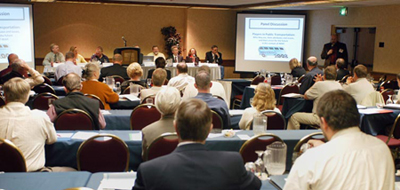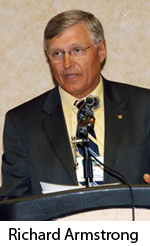
| CONNECTIONS |
IDAHO
ITD
HOME
511 TRAVEL SERVICES
IDAHO
DMV
ITD
NEWS
HIGHWAY
SAFETY
IDAHO STATE POLICE
STATE OF IDAHO
NIATT
NATIONAL
AASHTO
AAMVA
AAA of IDAHO
FEDERAL HIGHWAYS
FEDERAL AVIATION
IDAHO STATE POLICE
NHTSA
NTSB
TRB
U.S. DOT
TRANSPORTER
Archives
Milestones
Comments
Idaho
Transportation
Department
Office of Communications
P.O. Box 7129
Boise, ID 83707
208.334.8005
Fax: 208.334.8563


Mobility conference takes public transportation
step closer to the future
ITD’s Division of Public Transportation rolled out a new vision of mobility in Idaho to providers and users during a conference held in Boise this week (April 30, May 1).
“Mobility Idaho, 2008” was a crucial step toward implementing Idaho’s Mobility and Access Pathway or IMAP, a statewide public transportation plan recently approved by the Transportation Board.
Nearly 80 people representing public transportation interests statewide learned more about Public Transportation’s new emphasis on how best to move people instead of focusing on any one particular mode of transportation.
John Witmer, a community planner for Federal Transit Administration Region 10, told the group about emerging trends in public transportation coordination and the value of having a coordinated plan.
“The coordinated plan is basically a plan that involves all the key stakeholders identifying needs and strategies,” Witmer said. “The ultimate goal is to come up with a way to meet needs not currently being met.”
Planning agencies, transit riders, transportation providers, human services agencies, other government agencies, tribal representatives, elected officials and advocacy groups are among the key players that need to be involved in a coordinated plan, Witmer explained.
He encouraged participants to contact the FTA for technical assistance concerning grant applications.
“We have plenty of technical assistance available, so don’t try to reinvent the wheel,” he said.
“One thing about coordination is it never stops,” said Barbara Singleton, United We Ride (UWR) Region 10 ambassador. “The players are constantly changing.”
She went on to describe the Federal Interagency Coordinating Council on Access and Mobility’s UWR initiative and the opportunities it offers.
The UWR initiative is a high-priority, multi-year effort meant to enhance transportation services for people with disabilities, older adults and individuals with lower incomes. The initiative seeks to improve transportation coordination by breaking the barriers between transit and human service programs.
 “Idaho, you will probably be one of our stars,” Singleton said, citing ITD Public Transportation’s IMAP process and conference participation.
“Idaho, you will probably be one of our stars,” Singleton said, citing ITD Public Transportation’s IMAP process and conference participation.
Richard Armstrong, Idaho Department of Health and Welfare director, said that his agency administered about 150 programs and was Idaho’s largest state agency.
“We know that it is 50 percent less expensive to maintain someone in their home rather than in an institution,” Armstrong said, adding that transportation services are needed for that option to work.
“Many of our customers can’t drive,” he said. “Medicaid spends $18 million per year on transportation in Idaho.”
A panel discussion followed, featuring representatives from organizations with interests in better public transportation statewide.
Talks by ITD Director Pamela K. Lowe and Dan Dirks, chairman of the Community Transportation Association of America Board of Directors, opened a full day of conference activities.
The activities included formal roll out of the IMAP process by ITD Public Transportation Administrator Randy Kyrias, followed by small-group sessions. The conference concluded with breakout sessions by district for stakeholders.
Kyrias called the conference “an inspiring event that resulted in a tidal shift setting a new direction for Idaho’s mobility community.”
For true mobility and coordination to occur, stakeholders needed to be brought together including those who need transportation, those who provide it, those who purchase transportation and those who desire the economic benefits, he explained.
“The conference emphasized the absolute imperative to establish an open and supportive environment that encourages and nurtures effective partnerships, coalitions and networks,” Kyrias said.
Published 5-2-8